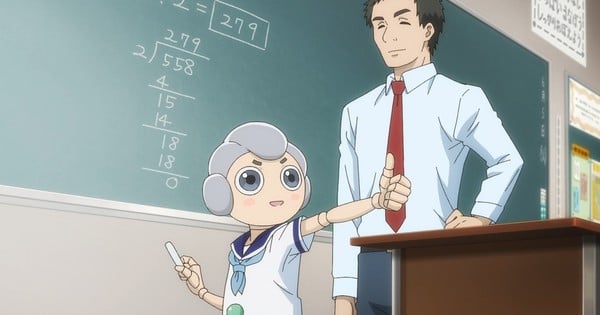Curated From www.animenewsnetwork.com Check Them Out For More Content.

© 山田胡瓜(秋田書店)/AIの遺電子製作委員会2023
The Gene of AI has yet to explicitly delineate the difference between Humanoids and the other AI that populate its setting, and that is surely deliberate on the writing’s part. Prior episodes have explored the space between androids with and without presumed sentience, and they’ve left it to the audience to determine how we feel about the validity of that separation. In universe, we haven’t witnessed or focused on any conflicts about AI versus Humanoids, and everyone seems to take their separate spheres as gospel. Many stories dealing with artificial intelligence hone in on the ethical implications of this discrepancy (or apparent lack thereof), so Gene‘s passive approach and non-sinister vibes make it stand out.
This also makes this week’s episode stand out, as we shift our focus away from Humanoids and towards these AI in humanoid bodies. “Robot” uses two examples to explore the interaction between a highly sophisticated algorithm and the sentient beings who utilize them, and surprisingly, Gene ends both stories on a positive note. The series has trended towards uncomfortable ambiguity with most of its resolutions, so it’s interesting to consider the difference here. In fact, doing so provides some perspective into what the writing tries to say in the grander thematic sense.
Learner’s story starts with his burned arms, tricking us into thinking we’re about to witness a case of robot abuse. Such a tack would not have felt out of character for Gene. Instead, we see the sentimental apprenticeship between the old metalworker Kiriyama and Learner in flashbacks. While it’s tempting to draw parallels between this relationship and current AI models for reproducing art, there’s no comparison when you think about it for more than a second. Learner’s tutelage under Kiriyama is entirely different and instructively so. Learner’s handlers get Kiriyama’s permission, which aligns with their motives. They want to preserve craft and techniques that, by Kiriyama’s own admission, could disappear with him, so it makes sense they’d want to perform this preservation in concert with the artisan’s wishes. There’s mutual respect.
Furthermore, Learner focuses on the process rather than the end product. In the end, he produces a better knife than Kiriyama, but only because he observes how to make a knife. He doesn’t skip steps or invent new ones; he reproduces them with better fidelity than a human can. Even still, Learner’s handlers recognize there’s only so much a machine can preserve. Kiriyama’s history with smithing, entwined with his memories of his father, can’t be passed down in this way. And Kiriyama’s passion, reignited by the new quality standard Learner shows him, can’t be reproduced by an algorithm. Moreover, that’s okay. Learner isn’t there to replace Kiriyama. He’s there for the benefit of future potential metalworkers. Theoretically, this is what we could be using artificial intelligence and machine learning for. They don’t have to be blunt, snake-oiled weapons wielded by corporations trying to filch artists of various trades out of their already meager livelihoods. There is another way.
Perm’s story similarly shows us a possible future where technology is used to help us and not exacerbate the ruling class’s worst impulses. Perm’s identity and relationships also become more complex than Learner’s. While Kiriyama eventually formed a bond with the robot, their relationship was ultimately a professional one between two adults (or one adult and an adult-emulating AI). Perm looks like a child and bonds with children, and children, notably, haven’t yet built up enough experience to harden the shells around their psyches. Children already attach themselves to inanimate objects much more quickly than adults can, so when you introduce an inanimate object that looks and acts like a person, the landscape becomes much thornier.
That said, Perm’s experience in the classroom is, by and large, wholesome. For better or worse, we don’t have a M3GAN situation. In talking to Sudo, his handler explains that while this hands-on experience is more prolonged and costlier than the higher-ups would like, he nevertheless believes this is the right way to train Perm’s brain. Again, it’s a far cry from current tail-devouring attitudes that see AI as a shortcut bypassing pesky human involvement. Machine learning as a tool only makes productive sense when used in concert with actual human needs. In Perm’s case, childcare is a field desperately in need of extra hands, and it’s also a field where one would want to be as careful as possible with mechanical supplements. Hence we see Perm’s training and subsequently evolving personality influenced by the many facets of real children. Gene, per usual, glosses over the myriad socioeconomic factors that would arise with AI caregivers—there isn’t enough time to cover that. But by focusing on the connection these children form with Perm, the story delivers a bittersweet yet satisfying emotional closure.
All in all, “Robot” proves to be a welcome departure for The Gene of AI. I personally don’t mind how often the series swerves into moral ambiguity and misanthropy, but I can also get more than my fill of that keeping up with current tech trends. It’s nice to know there’s still room for feel-good robot stories in my heart.
Rating:
Gene of AI is currently streaming on
Crunchyroll.
Steve is on Twitter until the day it completely succumbs to the t-shirt bots. You can also catch him chatting about trash and treasure alike on This Week in Anime.

